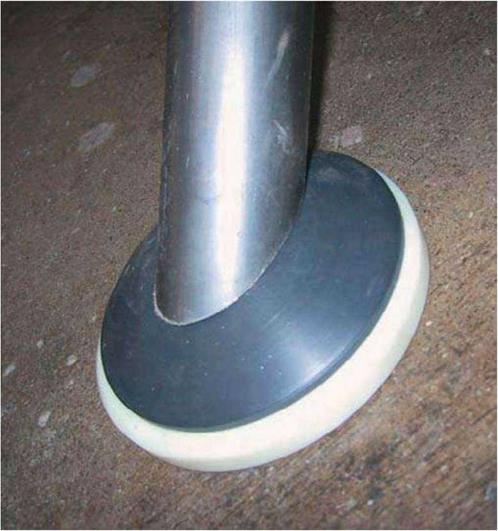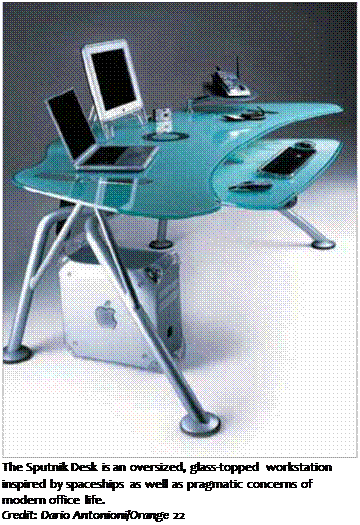 “I’d been designing work desk stations and modular systems for companies, and that got me to start thinking about the future of work and what a desk and work would mean or stand for in the future,” he says. “Being so involved with computers and technology as I am, I couldn’t separate my work from the digital realm, where we have all these peripheral devices that make our work life easier. The attempt was to create a simplified workstation that was ample enough to give you the workspace you need, but make it clean and unobtrusive.”
“I’d been designing work desk stations and modular systems for companies, and that got me to start thinking about the future of work and what a desk and work would mean or stand for in the future,” he says. “Being so involved with computers and technology as I am, I couldn’t separate my work from the digital realm, where we have all these peripheral devices that make our work life easier. The attempt was to create a simplified workstation that was ample enough to give you the workspace you need, but make it clean and unobtrusive.”
Because Antonini has long been inspired by airplanes and space travel, it was inevitable that the desk would also have a bit of the jetsons aesthetic as well. “I like to approach design from a narrative point of view,” Antonini says. When he began designing his dream desk, he asked himself, “If you were sitting at the controls of a space ship or your master universe desk, what would that thing look like? What would it be like?” Sputink became the answer to this question. “It would be an object that surrounded me and would facilitate bringing things to me, and my monitors would be around me and it wouldn’t look heavy or obtrusive,” he says. “It was about making work fun, creating something that makes you think, wow, I want to get behind that desk.” And there was just one more thing the desk had to do. “It’s also about making a desk that becomes a sculptural piece,” Antonini adds. “It has a built-in wow factor.”
While some of the Sputnik’s inspiration may have come from outer space, it also fulfills a whole host of down-to-earth needs. In addition to being an oversized computer workstation, it has built in wire management, an accessory arm, and a pullout keyboard – and-more tray that is itself as large as some desks. The shape looks futuristic, but it’s all about ergonomics. “If you diagram how the arms move during the course of a workday,” says Antonini, “you get a beautiful drawing of the limits of the arm reach as it covers the work area. And when they launch rocket ships, they go at a specific angle to get through the atmosphere. We wanted to give the piece this kind of trajectory idea, where the curves are long and sweeping.”
The work surface is also moveable. “The entire desktop surface rotates 15 percent in each direction on Teflon pads,” notes Antonini. “This allows you to slightly rotate your desk to have perfect viewing of your monitor or multiple monitors. It gives you that additional comfort.” The rotation is made possible by a supportive central column. “It’s like a bicycle steering column,” says Antonini. Because the glass weighs almost 200 pounds (91 kg), it requires substantive legs, which come off the central column out to the edges of the top, out of the way of chair and human legs. In keeping with his theme, Antonini designed this structure to “look like a lunar lander type of legs.” He continues, “When you look at
|
168 DESIGN SECRETS: FURNITURE |
|
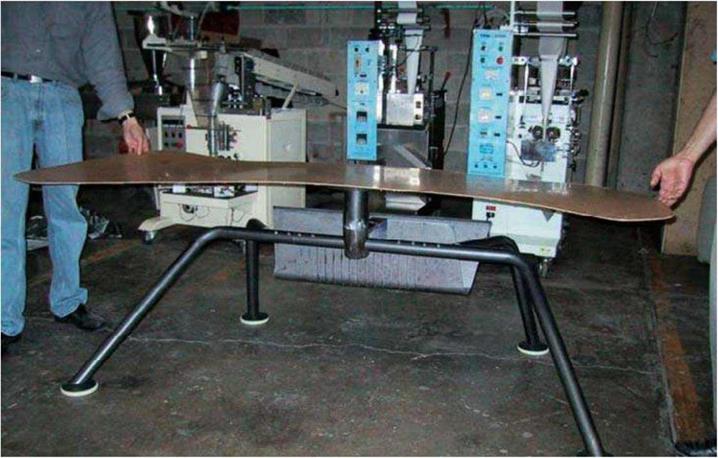
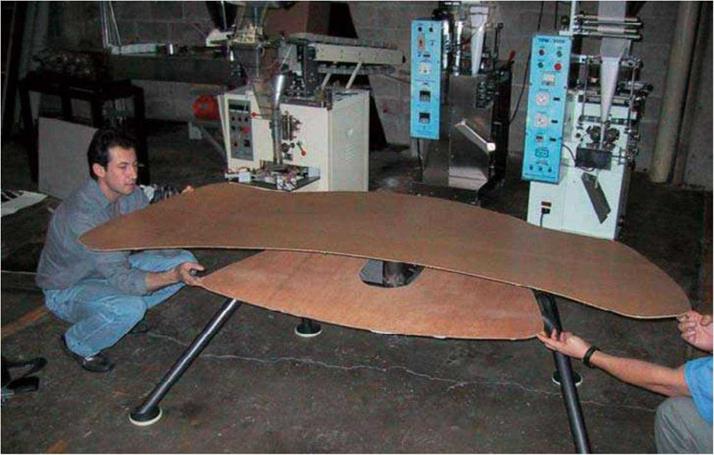
@ At the factory, cardboard templates are used to “test where the different structural parts were coming off the main frame and to see where things were going to be in contact with each other,” according to Dario Antonini of Orange 22. Credit: Dario Antonini/Orange 22
Antonini works out some design tweaks right on the factory floor. Antonini produces all his own products: “I’m not going to wait for these things to get made.” Credit: Dario Antonini/Orange 22
@ Antonini found the greatest design/manufacturing challenges to be finding the right balance between support and unobtrusive elegance for both the leg structure and the keyboard/accessories tray.
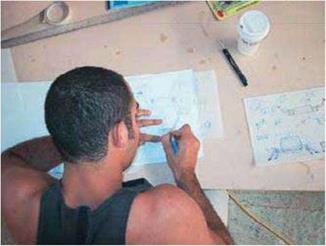 Credit: Dario Antonini/Orange 22
Credit: Dario Antonini/Orange 22
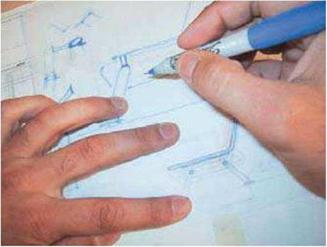
the mechanics of these exploration vehicles, they have fins or solar panels or some mechanical moving quality to them. This gives the desk that mechanical quality.”
The open metal envelope hanging off the back of the desk was made to catch the tangle of cables that are an inevitable byproduct of the modern office. “Because we imagined two to three monitors on this thing, we needed to address the wire-management issue,” says Antonini. “It was a must. I came up with the idea of making a contemporary-looking basket that holds all the wires so you don’t have to feed them, you can just pile them in. It covers them visually, but it’s an easy exercise.”
In addition to a small accessory island, there is also an oversized keyboard/accessory tray. “Because the desk is so big,” Antonini explains, “if you have something far away from you, you can’t reach it. So this accessory arm puts things out of the way, but lets you bring them in close to you to keep your worksurface more clear. The keyboard tray has full extension glides, so when it’s all the way out, it adds another quarter work surface to the desk.” This feature also proved to be the most challenging from a manufacturing perspective. “The most complicated part of that desk was determining the configuration of the arms that were to hold the keyboard tray,” Antonini notes. “We had drawn a series of solutions, and it took three or four iterations to get it clean and minimal.”
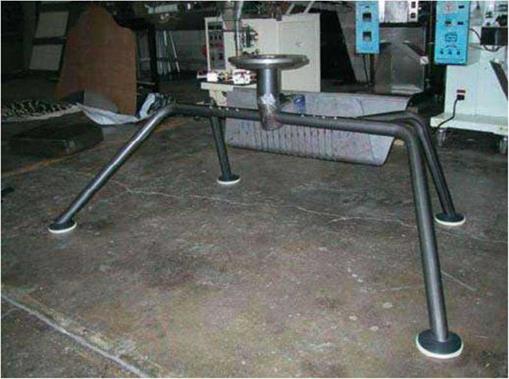
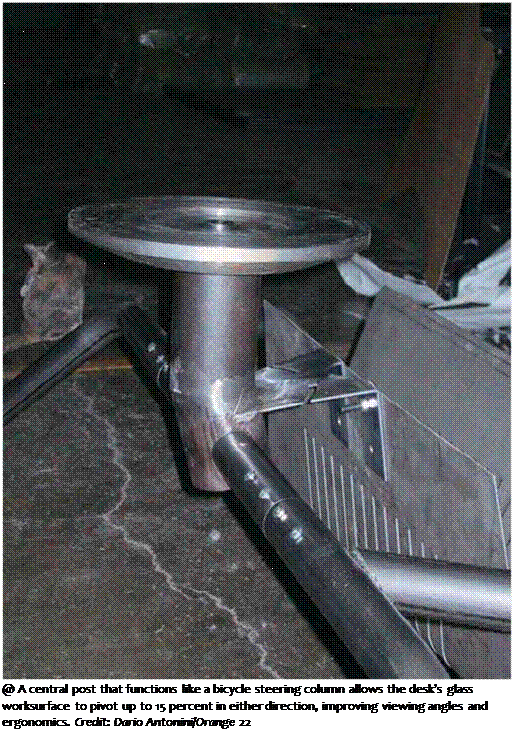
 |
Antonini and his company, Orange 22, handle their own production. “I’m not going to wait for these things to get made,” he says. “I’m going to make them myself.” In keeping with this attitude, Antonini balks a bit at being called a designer. “That label sometimes doesn’t sit with me so well,” he says. “I consider myself a maker of things.” The hands-on habit came to him early in life. “Ever since I was a kid, if my parents bought me a toy, I took it apart,” he says. “I wanted to see how it was made and what I could add to it. In that kind of tinkering, I learned to use my
|
|
Q Top: A metal basket hangs off the back of the Sputnik, ready to catch the inevitable pile of cables and cords of the wired workforce. Credit: Dario Antonini/Orange 22
® The underside of the glass worksurfaces are lightly sandblasted for an opaque finish. Credit: Dario Antonini/Orange 22
hands. If I couldn’t afford a toy, I’d make one.” Even today, the sense of play is very much a part of his design process. “I have this idea of being true to yourself, your innate self, the things that make you feel like a kid. This is what makes me happy, and I end up with things like the Sputnik.”
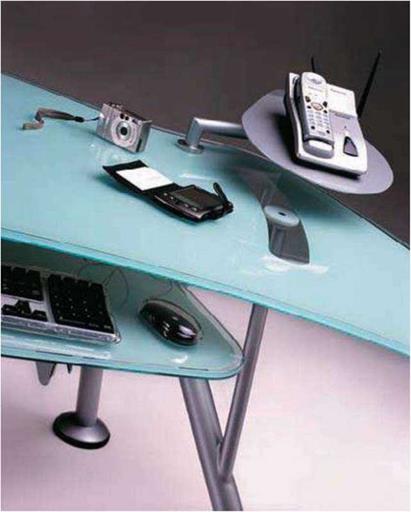
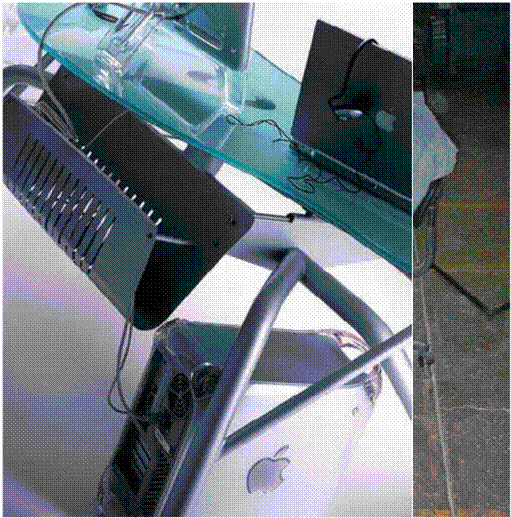 |
By managing his own manufacturing, Antonini feels that he can take more risks. “Part of the honesty of being a maker of things is a commitment to exploring and trying things that might not work,” he says. “What happens in the design world a lot, or when we’re working for clients, is that you have to get it right the first time around, and that fights against this innate sense of play. Part of why I started making our own products is so we can be free of the demands of high volume of sales, because selling this product is not the only way і make a living. The objects that come out of this approach and this mentality tend to be things that make people stop and say, ‘What is this?’ It’s how you get people to dream a little.”

